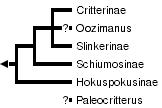Tree/Taxon List Formatting
The trees shown on ToL branch pages are constructed and formatted in TreeGrow's Tree Window. Taxon lists are built automatically based on tree structure, with descendents indented to their containing groups. The ToL Web Tools feature a button immediately below the tree or list that lets you toggle between the tree and list displays. In the Taxon Names form, you can enter author data and a brief description for a given taxon. This text can then be added to the taxon name in the tree or list of the containing group.
The tree/taxon list of a branch page should contain only the members of the group represented on the page. Do not include outgroups. Please also make sure that all the appropriate taxa for that page are displayed in the tree/taxon list, i.e., not just the ones that were included in a particular phylogenetic analysis, and not just the ones that occur in a particular faunal region. One reason for this requirement is to emphasize that the phylogenies presented should not just be the result of a single analysis, but should synthesize all available information. If the studies on which a page is based used only exemplar taxa, then the rest of the known taxa should be added to the tree or taxon list on the branch page. If the phylogenetic position of a taxon within a group is entirely unknown, it can be placed incertae sedis below the tree (see below).

Paleocritterus is shown as an extinct group.
Branch pages should ideally contain not only all Recent but also all extinct members of a group. We realize that many pages will currently have to remain incomplete in this respect, but authors should make an effort to include extinct groups whenever information on fossil taxa is available. Extinct groups should be marked as such in trees and taxon lists of branch pages.
If the tree on your branch page is very large, you should rotate branches so that the most frequently accessed terminal taxa are near the top of the page. This will make it easier for people to navigate to popular groups along the branches of the ToL.
Uncertainties About Phylogenetic Relationships

Critterus and Slitherus are sister groups, but relationships among the remaining Critterini are unresolved and therefore shown in a polytomy.

Oozimanus is placed incertae sedis in its putative position indicating a relationship with the Critterinae and Slinkerinae. Paleocritterus' position within the group is unresolved, so it is placed incertae sedis below the tree.

Critterus is non-monophyletic, while the monophyly of Tippytoa is uncertain.
Within most groups of organisms, there are some relationships that are controversial, uncertain, or completely unknown. If the phylogeny for your group has not yet been elucidated, it may be best to present a simple taxon list rather than a tree. In general, the relationships displayed in a tree should be based on robust hypotheses, and you should draw attention to areas of uncertainty by clearly marking affected branches. You can use one of the following tools to indicate lack of resolution:
- Polytomies
- If you are not sure about the phylogenetic relationships within a certain group of taxa, you can display this section of the tree as a polytomy. Alternative hypotheses about the relationships of the taxa participating in the polytomy should then be explained in the Discussion of Phylogenetic Relationships.
- If you are tempted to turn your entire tree into one big polytomy, it's probably better to display groups in a taxon list.
- Condidence of Placement
- Individual taxa of uncertain phylogenetic placement can be labelled as incertae sedis. They can either be included in the tree at their putative position (their branch marked with a ?), or they can be listed below the tree if their phylogenetic position is completely unknown. Please provide an account of any pertinent hypotheses for the placement of these taxa in the Discussion of Phylogenetic Relationships.
- If a taxon list is shown on a branch page rather than a tree, incertae sedis taxa will be marked(incertae sedis).
- Phylesis
- Sometimes, it may be necessary to create nodes in the tree that represent taxa that are non-monophyletic or for which monophyly is uncertain. This status should be clearly indicated in the tree (using special branch formatting), and it should be mentioned in the Discussion of Phylogenetic Relationships.
- If a taxon list is shown on a branch page rather than a tree, affected taxa will be marked (non-monophyletic) or (monophyly uncertain).
For some taxa, alternative hypotheses of phylogenetic position would result in placement of the taxon on different Tree of Life pages. For example, some people would prefer to place the turtles (Testudines) incertae sedis on the Amniota page, while others are confident that turtles are derived from within diapsids. However, each individual group should be featured as a terminal taxon on one and only one Tree of Life page. Therefore, whenever there are uncertainties about the proper containing group of a taxon, the relevant authors will have to reach a consensus as to which page should show the taxon in question as a descendent in the tree/taxon list. In order to make readers aware of alternative hypotheses, the potential placement of the taxon within other containing groups should then be noted in the 'Text after Tree' section of each potential containing group.
 Go to quick links
Go to quick search
Go to navigation for this section of the ToL site
Go to detailed links for the ToL site
Go to quick links
Go to quick search
Go to navigation for this section of the ToL site
Go to detailed links for the ToL site